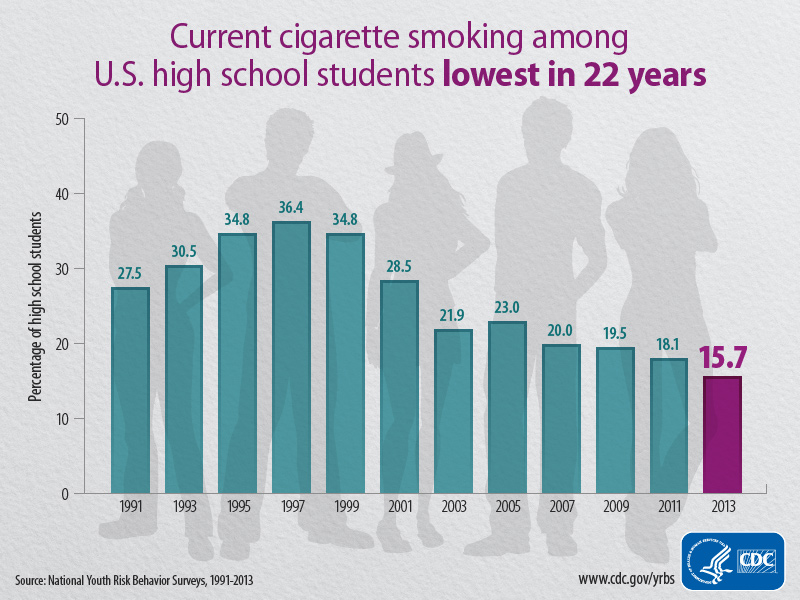Rates of cigarette smoking among high school students has dropped to lowest level in 22 years, the CDC reports.
In 2013, the smoking rate among high school students hit 15.7%, which means the U.S. government has already reached its goal of lowing the teen smoking rate to 16% of less by 2020. That’s according to the National Youth Risk Behavior Survey (YRBS), which began in 1991. Another important data set on teen smoking and drug use—Monitoring the Future (MTF)—reports the rate is at 16.3%. Regardless, both surveys show fewer kids are smoking.
That’s good news, and it’s likely thanks to a combination of several factors, the most important being the rising costs of cigarettes. Others include the growing stigmatization of smoking, with half of states prohibiting smoking in places like bars and restaurants. The adult smoking rate is dropping too, which means teens have fewer smoking role models.
If teens are passing around fewer packs of cigarettes, does that mean they’re not smoking other things? Past data has shown a 123% increase in the consumption of other smokable tobacco products like cigars and pipes, though the recent numbers from the larger data sets show no change in smokeless tobacco use since 1999, and a drop in cigar use.

One question you’re likely going to see is whether teens are switching to e-cigarettes. E-cigarettes is a subject the public health community is uncharacteristically split on. On one side of the spectrum, you have critics arguing that it’s possible e-cigarettes serve as a gateway to regular cigarettes. One vocal critic being the head of the CDC himself. “The increased use of e-cigarettes by teens is deeply troubling,” said CDC Director Dr. Tom Frieden in a statement about teen tobacco use going down. “Nicotine is a highly addictive drug. Many teens who start with e-cigarettes may be condemned to struggling with a lifelong addiction to nicotine and conventional cigarettes.”
Emerging data points to certain trends, but e-cigs are still so new. Earlier this fall, a CDC report showed that e-cig use among teens, while still low, had doubled in a year, from 3.3% in 2011 to 6.8% in 2012.
Dr. Kenneth Warner, a professor of health management and policy at the University of Michigan School of Public Health, looked back through the data and found that among kids who have never smoked a conventional cigarette, only 0.7% have ever tried an e-cigarette within the last 30 days. What this shows is that the same kids who are smoking regular cigarettes are smoking e-cigs.
“Everyone thinks they are right and the logical thing is that nobody knows,” says Warner. “This is a huge-stakes issue, because the proliferation of e-cigs has the potential to either reduce the cigarette problem or increase it over time among kids.”
The reality is we have a long way to go. It took 40 years to get the adult smoking rate down to around 20%, and it won’t be easy to cut it in half again. Warner and his colleague David Mendez have created a smoking-prevalence model that’s been used since the 1990s. Their predictions show that at the rate we are going, we might not be able to hit a 10% adult smoking rate until the middle of the century. But that’s if we don’t try anything radically different.
“I believe we will do better because I don’t think we’ll stick with just status quo tobacco control,” says Warner. “In my judgment, the future lies in how effectively FDA can regulate cigarettes and other [nicotine] products.”
The FDA announced it is expanding its regulatory powers to cover more tobacco products including e-cigs, but anti-smoking advocates are arguing it’s still not enough.
“The data on kids is great, but we have a long way to go before we can pack up and go home and say we solved the problem,” says Warner.
You can read more on the latest CDC numbers here.
More Must-Reads From TIME
- The 100 Most Influential People of 2024
- The Revolution of Yulia Navalnaya
- 6 Compliments That Land Every Time
- What's the Deal With the Bitcoin Halving?
- If You're Dating Right Now , You're Brave: Column
- The AI That Could Heal a Divided Internet
- Fallout Is a Brilliant Model for the Future of Video Game Adaptations
- Want Weekly Recs on What to Watch, Read, and More? Sign Up for Worth Your Time
Contact us at letters@time.com